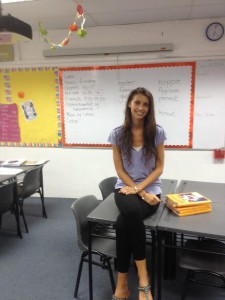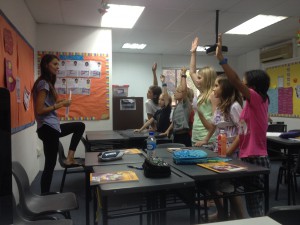At the Norwegian Supplementary School in Singapore, children get a sense of their home country a few hours a week. They polish up on their mother tongue language, in a culture where the English language dominates.
“So where did you look up all the info, Alexander?” Silje Merli, the teacher asks. “On nrk.no (Norwegian public broadcasting channels website)” Alexander answers. He has just finished a presentation in Norwegian on the sinking of the Titanic in front of the class, with a little support from the teacher.

Vårin is next up. She proudly presents her prepared text out loud.
“I got the information from Wikipedia, some from my father, and the rest from myself, “she says with a smile.
This class consists of 10 Norwegian students, five boys and five girls They are all Norwegian 5th graders in Singapore. They are some of the 75 Norwegian students that are enlisted at The Norwegian Supplementary School. The school is a Non-profit Organisation, mainly funded by the parents of the children and has existed since 1983. There are 9 teachers who take turns teaching classes. They teach Norwegian children, of different age groups, two hours of mother tongue language every Thursday.
The supplementary classes typically take place every Thursday afternoon, following regular classes in the morning at the Overseas Family School, located right next door. At OFS, an international school in Singapore with kids from all over the world, English is the leading language for communication and instruction.
A sense of back home
The main purpose of the weekly Norwegian language instruction is to support children maintain and develop competence of their mother tongue, Silje Merli, the schools supervisor and 5th grade teacher, points out.
“Most of the children go to the International Schools, and some of them have been in Singapore for many years. When living abroad and far away from Norway, our ambition is to help them with the Norwegian language as well as give them a touch of the Norwegian culture and traditions”.
At the Norwegian Supplementary School, classes also cover subjects as social science and religion & ethics. At the same time, these classes are designed to familiarize the children with the uniqueness of the Norwegian curriculum.
The social aspects of the weekly classes cannot be emphasized enough.
“When a child moves away from their home culture, everything is new, unfamiliar and can be challenging. It is important to let them know that there are other children in the same situation,“ Silje Merli says.
Something to look forward to
For the two girls, Vårin and Sunniva, the weekly Norwegian class is something they look forward to.
“I am always eager to be here, and it is nice to speak Norwegian with other friends and classmates,” Sunniva says. She has only been living in Singapore for three months, since her father started working for Norwegian company, Veritas,. Vårin has been living here for six months, while her father works at an offshore oil platform. They both agree, that the Siljes way of teaching is a little different from what they are used to at OFS, where things are a bit more strict and disciplined.
The little difference is not a coincidence, Silje Merli points out.
“We strive to achieve a good balance: enjoyable social interactions and fun activities, while at the same time trying to encourage learning and polishing up on Norwegian. We want the learning experience to complement the international curriculum.”
Silje Merli believe the students are influenced by the local and the international school system, whereas at the NorwegianSupplementarySchool the teaching style has its roots in the Norwegian system.
“Friminutt”
Except for the two big air-conditioning units and posters on the walls with English texts from Korean, Japanese and American children, the classroom this Thursday afternoon could have been mistaken for any standard classroom in Norway.
The five boys, all typical Norwegian-looking with bright long hair sat at one table, while the girls are split into groups of two. It is time for vocabulary session. “What is a flea market?” Silje asks. “A noun“, 10-year-old Sunniva responded, raising her hand in the air.
A fifteen minute break was up, or “friminutt” as one says in Norwegian. Once a week they all go down to the big schoolyard to play basketball, football, look at their smartphones or just chat with some of the many other students from all over the world, switching to English before coming back to the mother language in a few minutes.
Split culture
In the 5th grade class, students’ length of stay in Singapore range from just a couple of months to eight years. When eight out of ten years of one’s life have been abroad, questions about one’s identity tend to pop up every once in a while. That is something they try to address in class as well.
“Who am I? Where is my home? Is it Singapore or Norway? Some of the students are young children when they come here, but some are almost adolescents. Either way it is difficult to re-establish oneself in a new society and culture, so we try to cover that part as well,“ Silje Merli said. “We want the children to familiarize and have a strong connection to the Norwegian culture as well as the Singaporean”.
It’s time for a test of awareness and memorization, before the students are picked up by the parents, typically the mothers, some of them already waiting outside the glass window.
All the students gather in front of the blackboard to look at five different-looking pictures. They were given two minutes to try to take in as many details as possible. A fun, little quiz for the students, and it’s obvious to see, that the children enjoys playing the game.
Then Silje Merli told the students that she is not teaching the class next week, so they would have to deal with a substitute teacher. Some of the children visibly let out a small sigh, but a smiling Silje told them not to worry. “The temp is also Norwegian and I have already told her how things work in this class”.



